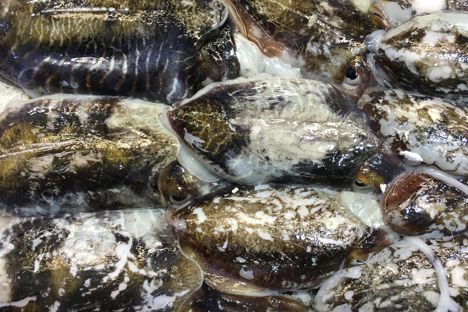Cuttlefish, the perhaps lesser-known relative of octopus and squid, is commonly eaten in East Asia and is popular across Mediterranean Europe. They grow to an average size of 15–25cm, although they have been known to reach monstrous sizes of double that. They are in season from January to October but are at their best during the first three months of the year.
Very similar in flavour to squid, cuttlefish is a cheaper alternative and a very underutilised seafood in Britain. A favourite in Italy and Spain, most of the thirty tons caught every day on the UK’s south coast are exported, but if you do come across cuttlefish at your fish mongers it’s well worth a try.
When buying cuttlefish whole, look for slightly translucent flesh with iridescent patches on the skin and no cuts or tears. The flesh should be firm and elastic, and not slimy or gritty – a good wash in cold water should get rid of any sand.
How to prepare cuttlefish
Due to the ink sack, preparing cuttlefish can be a messy affair, so empty your sink and wear an apron. Aside from potential mess, the preparation is actually very easy. Cut below the eyes to remove the tentacles and gently pull the head out along with the guts, taking care not to burst the ink sack. Reserve the ink sack – the ink is rich and seaweed-like in flavour and of course has that brilliant jet black colour, perfect for stirring through a seafood risotto or pasta dough. Rinse in cold water to wash away any sand or spilled ink.
Pull out the beak and discard, and pull the outer membrane from the body (you may need to aid your grip with a tea towel). You’ll be left with a bright, brilliant white tube ready to slice into rings calamari-style, stuff or score.
How to cook cuttlefish
Like squid, cuttlefish must be cooked quickly at a high temperature (not giving the connective tissue enough time to toughen up) or slowly at a low temperature (giving enough time to break down the connective tissues completely). The tentacles and ‘wings’ are tougher and are best slow-cooked.
For a quick method, score and marinate your cuttlefish for a couple of hours – Asian flavours like soy, chilli and bashed coriander stalks works well – or go for a Mediterranean approach with lemon, garlic, basil and a good glug of olive oil. Flash-fry in a smoking hot pan or barbecue for 30 seconds on each side, then serve immediately with a squeeze of fresh citrus and a crunch of sea salt.
For a rich, slow-cooked dish, braise the cuttlefish in wine (red or white) and pair with a smoky or cured meat such as bacon, chorizo or ‘nduja. If you can get hold of baby cuttlefish, they are great for stuffing – fill with rice and chorizo and braise in red wine. Nathan Outlaw serves in a warm salad of cuttlefish with purple sprouting broccoli, tarragon and zingy capers, having braised the cuttlefish in white wine and fish stock.
If you are lucky enough to find fresh cuttlefish, the sweet flesh is beautiful raw in a tartare, ceviche or sashimi dish.
Get in touch
Please sign in or register to send a comment to Great British Chefs.



